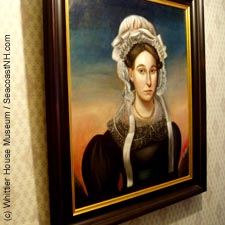|
FRESH STUFF DAILY |
|
|
||
|
|
||
|
|
||
|
SEE ALL SIGNED BOOKS by J. Dennis Robinson click here |
||
Harriet was almost normal. Legend says that, had she not been spurned by her fiance, Harriet might have lived like a wealthy socialite. Instead she became one of the nation’s first female preachers, and author, an evangelist for the Apocalypse and a famous figure in Whittier’s best-selling poem Snow Bound.
HARRIET LIVERMORE Born into one of New Hampshire’s powerful families, Harriet Livermore gave up wealth and status to become an itinerant preacher in an age when upper class women were seen, but seldom heard, in public. Casting aside fineries, she traveled the world more than many sea captains and lived a harsher life. Her mission was to rid the world of the encroaching evil she saw all around her. This self-confessed "pilgrim stranger" began her days as a New Hampshire socialite. Her grandfather Samuel Livermore married Jane Browne, daughter of a prestigious Portsmouth minister during the peak of the city’s British rule. Yet Samuel managed to adapt from a King’s Attorney to a trusted Congressman and Senator after the Revolution. Harriet’s father too served in the fledgling United States Congress, but his wife died when Harriet was just five. She was all but abandoned to nursemaids and private finishing schools. Harriet Livermore almost led a normal life. While at nearby Atkinson Academy, she met the man of her dreams, but both families opposed the union. When he died years later in the War of 1812, Harriet resolved to become a preacher. Her three cousins were clerics, but the calling was not considered proper work for a woman, even one as dynamic and brilliant as she. Casting about for a doctrine she could believe in, Harriet embraced the apocalyptic Adventist vision. She began writing books, traded her aristocratic clothing for homespun, and separated from her wealthy family. In an gesture of religious transformation, she cut off three feet of dark silky tresses and thereafter appeared with close cropped hair. This severe look confounded and yet captivated listeners as she preached of doomsday and atonement in homes, in schools, on docks and street corners – anywhere people would listen. In the last century Livermore was known primarily for her characterization in "Snow-Bound" by local poet John Greenleaf Whittier. She is the "not unfeared, half-welcome guest" who visited with the Whittier’s Quaker family in Massachusetts. The poet notes her legendary temper, her lustrous eyes and "unbent will's majestic pride". When Livermore first read Whittier's description of her, legends says, she threw the book across the room. Today Livermore is recognized as a striking example of what was a much larger movement of women preachers than standard history admits. She has been adopted by modern feminists, but she herself accepted male authority as gospel. Remarkably, she was invited to lead the US Congress in prayer on four occasions under four presidents. This was a time when church and state were tightly aligned and church services were held inside the House of Representatives. Livermore warned political leaders of the pending Apocalypse in a fire and brimstone address that lasted well over an hour and reportedly moved a number of the assembled politicians to tears. Livermore became a strong advocate of Indian rights in a time when Native Americans were being confined to reservations or killed in war by the American government during the nation's move West. She came to believe the beleaguered people were the famed lost tribe of Israel, but fearing her tendency to treat Indians with equality, she was ejected from Kansas by the Bureau of Indian Affairs during her missionary work there. She traveled, often alone, to the Holy Land of Jerusalem five separate times, relying on the kindness of strangers and on a slim income from her writing and sponsors. Finally, at the age of 80, having suffered unrelenting discrimination, misunderstood and impoverished, she died in an alms house in Philadelphia. Harriet Livermore lived long enough to see her first doomsday prediction fail, but not long enough to see the free state of Israel for which she advocated tirelessly. She dreamed, she wrote, of a day when women would be "clothed in the sun, and walk on the moon." By Maryellen Burke and J. Dennis Robinson. All right reserved. Top picture from the Whittier House Museum in Amesbury, MA by J. Dennis Robinson. Used by permission. All rights reserved. Please visit these SeacoastNH.com ad partners.
News about Portsmouth from Fosters.com |
| Friday, April 19, 2024 |


|
Copyright ® 1996-2020 SeacoastNH.com. All rights reserved. Privacy Statement
Site maintained by ad-cetera graphics

 Link Free or Die
Link Free or Die



















